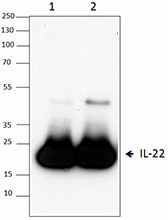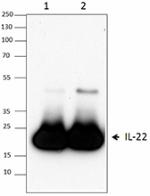- Clone
- BL35175 (See other available formats)
- Regulatory Status
- RUO
- Other Names
- Interleukin-22, IL-TIF, IL-10-related T-cell-derived-inducible factor
- Isotype
- Rat IgG2a, κ
- Ave. Rating
- Submit a Review
- Product Citations
- publications

-

Western blot analysis of 50 ng of recombinant human IL-22 (lane 1) and 50 ng of recombinant mouse IL-22 (lane 2) using purified anti-mouse IL-22 (clone BL35175) antibody.
| Cat # | Size | Price | Quantity Check Availability | Save | ||
|---|---|---|---|---|---|---|
| 517501 | 25 µg | 124 CHF | ||||
| 517502 | 100 µg | 265 CHF | ||||
IL-22, a cytokine structurally related to IL-10, was originally identified in the mouse as a gene induced by IL-9 in T cells and mast cells. IL-22 was initially designated as IL-TIF (IL10-related T cell-derived inducible factor). Mouse IL-TIF consists of 179 amino acids, including four cysteins, and has a predicted molecular weight of 20 kD. Biological activity of IL-22 is initiated by binding to a cell-surface complex composed of IL-22R1 and IL-10R2 receptor chains and further regulated by interactions with a soluble binding protein, IL-22BP, which shares sequence similarity with an extracellular region of IL-22R1 (sIL-22R1). Both chains of the IL-22R complex belong to the class II cytokine receptor families. Two types of IL-22-binding receptor have been discovered, a membrane-bound receptor and a soluble receptor, both encoded by different genes. IL-22 is produced by immune cells and acts on non-immune cells to regulate local tissue inflammation. As a product of the recently identified T helper 17 lineage of CD4(+) effector lymphocytes, IL-22 plays a critical role in mucosal immunity as well as in dysregulated inflammation observed in autoimmune diseases.
Product DetailsProduct Details
- Verified Reactivity
- Mouse, Human
- Antibody Type
- Monoclonal
- Host Species
- Rat
- Immunogen
- Mature recombinant protein mouse Interleukin-22 (Leu34-Val179)
- Formulation
- This antibody is provided in phosphate-buffered solution, pH 7.2, 0.09% sodium azide.
- Preparation
- The antibody was purified by affinity chromatography.
- Concentration
- 0.5 mg/ml
- Storage & Handling
- Upon receipt, store undiluted between 2°C and 8°C.
- Application
-
WB - Quality tested
- Recommended Usage
-
Each lot of this antibody is quality control tested by Western blotting. Western blotting, suggested working dilution(s): Use 0.5 µg/ml dilution buffer for each mini-gel.
- Application Notes
-
Clone BL35175 has been shown to be useful for detecting mouse and human IL-22 by Western blotting.
- Product Citations
-
- RRID
-
AB_10695475 (BioLegend Cat. No. 517501)
AB_10694243 (BioLegend Cat. No. 517502)
Antigen Details
- Structure
- 179 aa with with a putative 33 aa signal peptide that is cleaved to generate a 147 aa mature protein.
- Distribution
-
Secreted, Th17
- Function
- Cytokine that contributes to the inflammatory response in vivo.
- Ligand/Receptor
- Binds to IL-22 receptor complex that consists of two receptor subunits, IL22R and IL10Rβ.
- Cell Type
- Th17
- Biology Area
- Cell Biology, Signal Transduction
- Molecular Family
- Cytokines/Chemokines
- Antigen References
-
1. Dumoutier L, et al. 2000. J. Immunol. 164:1814.
2. Xie MH, et al. 2000. J. Biol. Chem. 275:31335.
3. Jones BC, et al. 2008. Structure 16:1333.
4. Sonnenberg GF, et al. 2010. J. Exp. Med. 207:1293.
5. Kotenko SV, et al. 2001. J. Immunol. 166:7096.
6. Chang C, et al. 2006. Cell Research 16:902. - Gene ID
- 50929 View all products for this Gene ID
- UniProt
- View information about IL-22 on UniProt.org
Related FAQs
Other Formats
View All IL-22 Reagents Request Custom Conjugation| Description | Clone | Applications |
|---|---|---|
| Purified anti-mouse IL-22 | BL35175 | WB |
Compare Data Across All Formats
This data display is provided for general comparisons between formats.
Your actual data may vary due to variations in samples, target cells, instruments and their settings, staining conditions, and other factors.
If you need assistance with selecting the best format contact our expert technical support team.
-
Purified anti-mouse IL-22

Western blot analysis of 50 ng of recombinant human IL-22 (l...
 Login / Register
Login / Register 









Follow Us